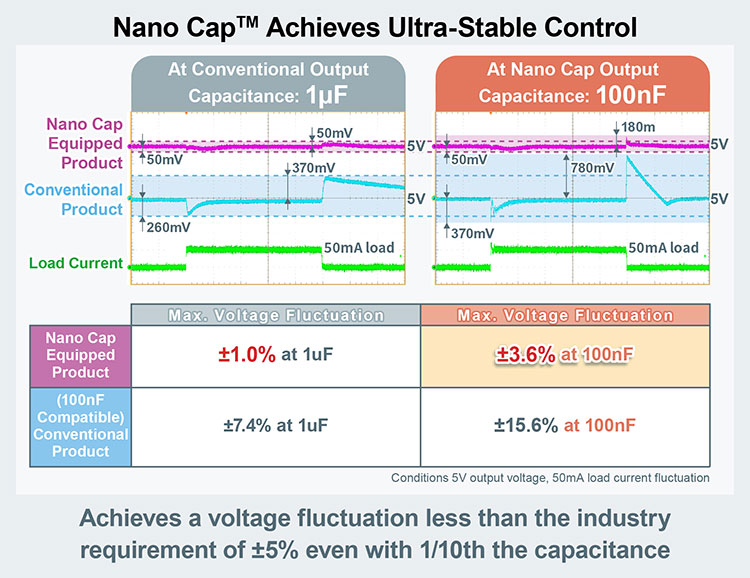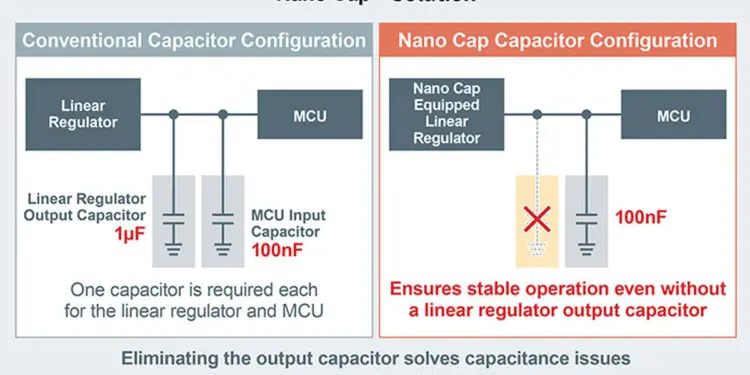ROHM announces the development of Nano Cap™ power supply technology that ensures stable control of power supply circuits in the automotive and industrial fields – even with ultra-small capacitances in the magnitude of nF (Nano: 10-9).
The growing awareness for sustainable energy consumption has led to greater electrification in a variety of applications. Especially in the automotive field, the number of electrical components continues to increase due to technological innovations spurred by advances in EVs and autonomous driving. Each of these electrical applications requires a variety of voltage sources, all of them stabilized by capacitors. This results in an increasing demand of external components, increasing PCB sizes and adding cost to the Bill of Material.
Following the development of ultra high-speed pulse control technology Nano Pulse Control™ and ultra-low current technology Nano Energy™, ROHM has added a third Nano power supply technology, Nano Cap™, that reduces the number of external capacitors required for linear regulators.
In a circuit, typically comprised of a linear regulator and MCU, a 1uF capacitor is usually required at the output of the linear regulator while 100nF is requested at the input of the MCU. However, leveraging ROHM’s linear regulator utilizing Nano Cap™ technology – developed by combining analog expertise covering circuit design, layout, and processes – eliminates the need for the capacitor at the regulator output and ensures stable operation with just the 100nF input capacitor. By decreasing both the number of capacitors along with the capacitance needed for power supply circuits in the automotive and other fields, ROHM can contribute to minimizing circuit design load.
Furthermore, Op amp samples utilizing Nano Cap™ technology have already been released in part, and linear regulators utilizing Nano Cap™ technology as well as LED drivers that built-in Nano Cap™ equipped regulators are scheduled to be released in 2020.
ROHM is committed to further enhancing the development of Nano CapTM technology to completely eliminate the need for capacitors while expanding the use of this technology not only to linear regulators, but Op amps, LED drivers, and other analog ICs as well, which contribute to society through the effective use of resources that minimizes environmental load.
About Nano Cap™ Technology
Nano Cap™ power supply technology refers to ultra-stable control technology achieved by combining advanced analog expertise covering circuit design, processes, and layout utilizing ROHM’s vertically integrated production system. Optimized control eliminates the problem of operational stability regarding capacitors in analog circuits, contributing to a reduction in design time for a wide range of applications in the automotive, industrial equipment, consumer, and other fields.
Details of Nano Cap™ Technology
Nano Cap provides stable control of linear regulator output by improving response in analog circuits while minimizing parasitic factors related to wiring and amplifiers, making it possible to reduce the output capacitance to less than 1/10th over conventional solutions.

As a result, circuits composed of a linear regulator and MCU which usually require a 1uF capacitor at the output of the linear regulator and a 100nF at the input of the MCU as mentioned above, ROHM’s Nano Cap™ linear regulator technology achieve stable operation using just one 100nF capacitor at the MCU side.
Given an industry requirement for output voltage fluctuation of ±5.0% max. (in case focusing on just fluctuation) with respect to 50mA load current fluctuation with 100nF capacitance, Nano Cap™ equipped chips achieve a stable operation of ±3.6% in the evaluations, compared with conventional linear regulators whose output voltage can vary by as much as ±15.6%.
Other Nano Power Supply Technologies
ROHM established Nano power supply technologies by incorporating proprietary analog expertise that combines circuit design, processes, and layout utilizing a vertically integrated production system. The following are other Nano power supply technologies centered on power supply ICs developed by ROHM that contribute to solving application issues in a wide range of products.
Nano Pulse Control™
Refers to ROHM’s ultra-high-speed pulse control technology for power supply ICs that achieves a switching ON time (control width of the power supply IC) on the order of nanoseconds (ns), making it possible to convert from high to low voltages using a single IC – unlike conventional solutions requiring 2 or more power supply ICs. This contributes to greater miniaturization and system simplification in 48V applications ranging from mild hybrid vehicles and industrial robots to base station sub power supplies.
Nano Energy™
This ultra-low current technology features a no-load current consumption in the nA range by minimizing the trade-off that occurs when reducing current consumption at ultra-light loads. As a result, 10-year drive on a single coin battery demanded by the IoT market is possible, supporting long-term operation in compact battery-driven applications, including portable devices, wearables, and IoT.

































